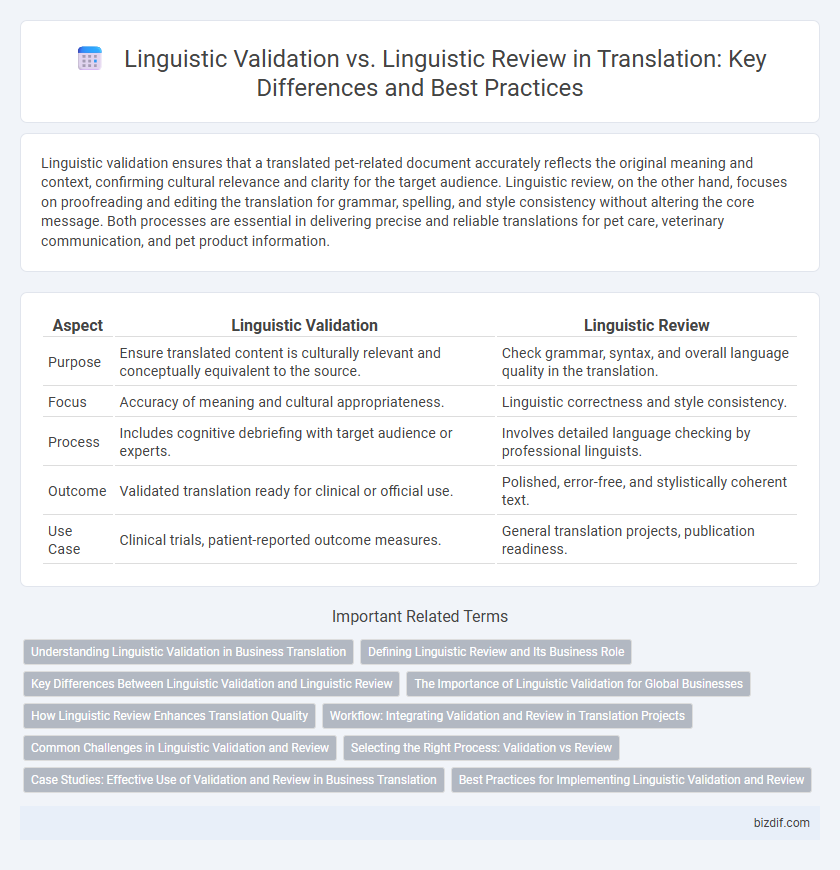Linguistic validation ensures that a translated pet-related document accurately reflects the original meaning and context, confirming cultural relevance and clarity for the target audience. Linguistic review, on the other hand, focuses on proofreading and editing the translation for grammar, spelling, and style consistency without altering the core message. Both processes are essential in delivering precise and reliable translations for pet care, veterinary communication, and pet product information.
Table of Comparison
| Aspect | Linguistic Validation | Linguistic Review |
|---|---|---|
| Purpose | Ensure translated content is culturally relevant and conceptually equivalent to the source. | Check grammar, syntax, and overall language quality in the translation. |
| Focus | Accuracy of meaning and cultural appropriateness. | Linguistic correctness and style consistency. |
| Process | Includes cognitive debriefing with target audience or experts. | Involves detailed language checking by professional linguists. |
| Outcome | Validated translation ready for clinical or official use. | Polished, error-free, and stylistically coherent text. |
| Use Case | Clinical trials, patient-reported outcome measures. | General translation projects, publication readiness. |
Understanding Linguistic Validation in Business Translation
Linguistic validation in business translation ensures that the translated content accurately conveys the original message's intent, cultural nuances, and terminology specific to the industry. This process involves rigorous testing with native speakers and target users to confirm clarity, relevancy, and comprehension, reducing risks of miscommunication in global markets. In contrast, linguistic review primarily focuses on grammar, style, and consistency without validating the text's functional effectiveness with end-users.
Defining Linguistic Review and Its Business Role
Linguistic review involves a systematic evaluation of translated content to ensure accuracy, cultural relevance, and terminological consistency within a target market. It plays a crucial business role by mitigating risks related to miscommunication and brand misalignment, ultimately supporting market expansion and customer trust. This process differs from linguistic validation, which focuses on confirming the functional equivalence of translations in clinical trials or regulated industries.
Key Differences Between Linguistic Validation and Linguistic Review
Linguistic validation ensures the translated content accurately reflects the original meaning through thorough testing with native speakers to maintain cultural relevance and comprehension. Linguistic review focuses on quality control by checking grammar, syntax, consistency, and terminology within the translation. Key differences include validation's emphasis on usability and functional equivalence, while review prioritizes linguistic accuracy and adherence to style guides.
The Importance of Linguistic Validation for Global Businesses
Linguistic validation ensures that translations are not only accurate but also culturally appropriate, which is critical for global businesses aiming to maintain brand consistency across diverse markets. This process involves rigorous testing with target language speakers to confirm that the message resonates correctly and meets local regulatory requirements. Implementing linguistic validation mitigates the risk of miscommunication, enhances customer trust, and supports successful international product launches.
How Linguistic Review Enhances Translation Quality
Linguistic review enhances translation quality by systematically identifying and correcting errors related to grammar, terminology, and cultural appropriateness, ensuring consistency across the text. This process involves native-speaking experts who validate the translation's accuracy and fluency, improving readability and user comprehension. By refining the translation beyond basic linguistic validation, linguistic review ensures that the final output aligns with target audience expectations and industry standards.
Workflow: Integrating Validation and Review in Translation Projects
Workflow integration of linguistic validation and linguistic review in translation projects streamlines consistency by ensuring that translated content accurately reflects source material while maintaining cultural and contextual relevance. Linguistic validation involves rigorous testing with native speakers to confirm usability and comprehension, whereas linguistic review focuses on editorial quality and adherence to linguistic standards. Combining these processes within a unified workflow enhances efficiency, reduces errors, and improves overall translation accuracy.
Common Challenges in Linguistic Validation and Review
Common challenges in linguistic validation include ensuring cultural relevance and accuracy while maintaining consistency across multiple target languages, often hindered by regional dialect variations and idiomatic expressions. Linguistic review faces difficulties in identifying subtle translation errors and stylistic inconsistencies that could impact the overall quality and clarity of the content. Both processes require rigorous collaboration between translators, reviewers, and subject matter experts to achieve linguistic and contextual fidelity.
Selecting the Right Process: Validation vs Review
Selecting the right process between linguistic validation and linguistic review hinges on the project's goals and quality requirements. Linguistic validation ensures that a translation is culturally and conceptually equivalent to the source, typically involving target audience testing, while linguistic review focuses on language accuracy, consistency, and style without additional user validation. Prioritizing linguistic validation is essential for clinical trials and regulatory submissions, whereas linguistic review suffices for marketing materials and internal communications.
Case Studies: Effective Use of Validation and Review in Business Translation
Case studies reveal that linguistic validation ensures translations maintain cultural and contextual accuracy, crucial for business documents targeting global markets. Linguistic review complements this by refining terminology consistency and grammatical precision, enhancing overall translation quality. Together, these processes reduce risk of miscommunication and improve brand credibility in international business.
Best Practices for Implementing Linguistic Validation and Review
Linguistic validation ensures translations accurately convey the original content's intent, maintaining cultural relevance and regulatory compliance, while linguistic review focuses on quality assurance through consistency and language accuracy. Best practices include involving native-speaking experts, employing standardized glossaries, and conducting iterative testing with target users to identify and resolve discrepancies. Integrating both processes within a structured workflow optimizes translation quality and enhances overall project reliability.
Linguistic Validation vs Linguistic Review Infographic

 bizdif.com
bizdif.com